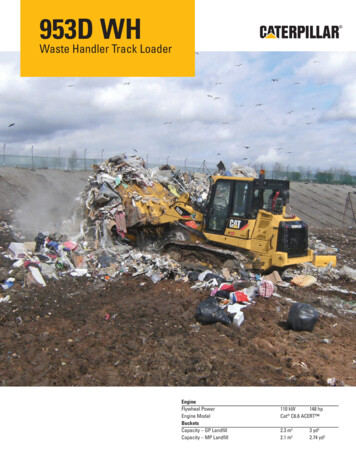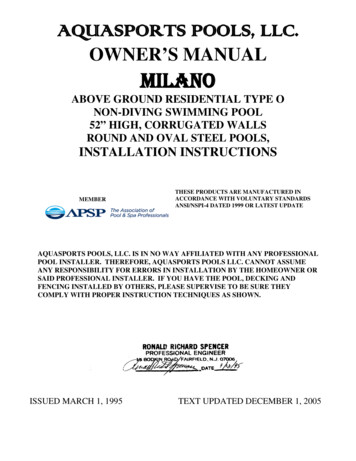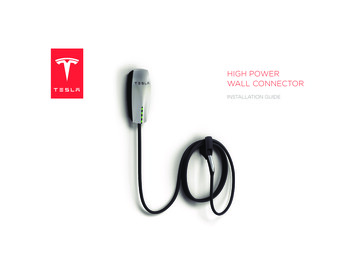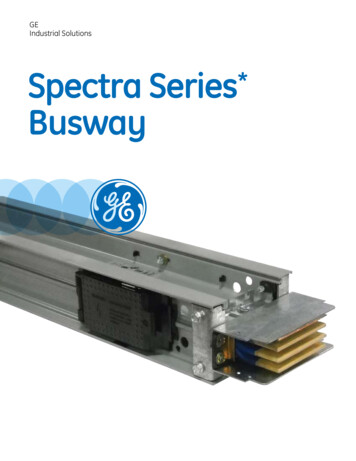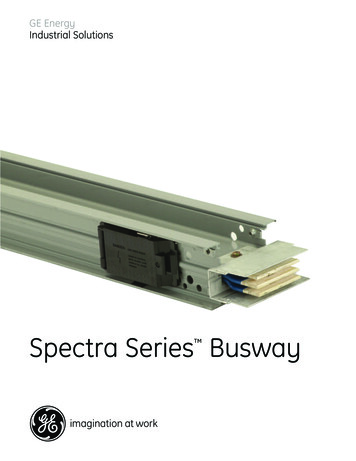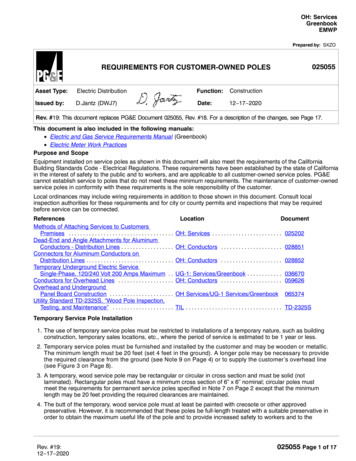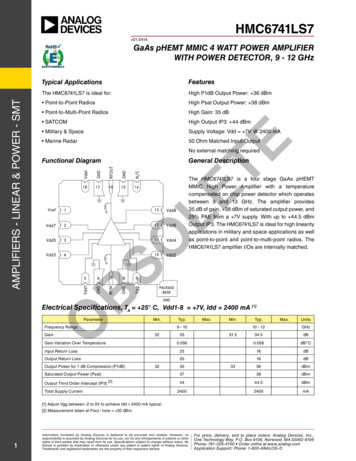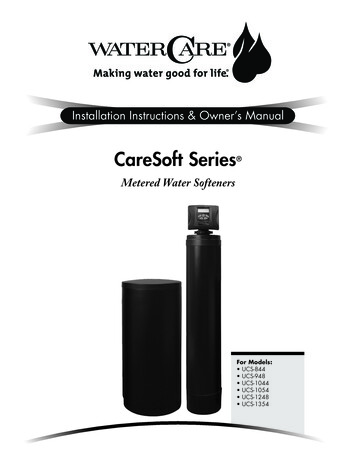
Transcription
An Introduction to Thermogeology:Ground Source Heating and Cooling
For Jenny ‘the Bean’
An Introduction to Thermogeology:Ground Source Heating and Cooling2nd EditionDavid BanksHolymoor Consultancy LtdUKA John Wiley & Sons, Ltd., Publication
This edition first published 2012 2008 David Banks 2012 John Wiley & Sons, LtdWiley-Blackwell is an imprint of John Wiley & Sons, formed by the merger of Wiley’sglobal Scientific, Technical and Medical business with Blackwell Publishing.Registered office:John Wiley & Sons, Ltd, The Atrium, Southern Gate, Chichester, West Sussex, PO19 8SQ, UKEditorial offices:9600 Garsington Road, Oxford, OX4 2DQ, UKThe Atrium, Southern Gate, Chichester, West Sussex, PO19 8SQ, UK2121 State Avenue, Ames, Iowa 50014-8300, USAFor details of our global editorial offices, for customer services and for information abouthow to apply for permission to reuse the copyright material in this book please see ourwebsite at www.wiley.com/wiley-blackwell.The right of the author to be identified as the author of this work has been asserted inaccordance with the UK Copyright, Designs and Patents Act 1988.All rights reserved. No part of this publication may be reproduced, stored in a retrieval system, ortransmitted, in any form or by any means, electronic, mechanical, photocopying, recording or otherwise,except as permitted by the UK Copyright, Designs and Patents Act 1988, without the prior permissionof the publisher.Designations used by companies to distinguish their products are often claimed as trademarks. All brandnames and product names used in this book are trade names, service marks, trademarks or registeredtrademarks of their respective owners. The publisher is not associated with any product or vendormentioned in this book. This publication is designed to provide accurate and authoritative informationin regard to the subject matter covered. It is sold on the understanding that the publisher is not engagedin rendering professional services. If professional advice or other expert assistance is required, theservices of a competent professional should be sought.Library of Congress Cataloging-in-Publication DataBanks, David, 1961–An introduction to thermogeology : ground source heating and cooling / David Banks. – 2nd ed.p. cm.Includes bibliographical references and index.ISBN 978-0-470-67034-7 (hardcover : alk. paper)1. Ground source heat pump systems. I. Title.TH7638.B36 2012697'.7–dc232011045231A catalogue record for this book is available from the British Library.Wiley also publishes its books in a variety of electronic formats. Some content that appears in print maynot be available in electronic books.Cover image:Main photo: Coils of heat exchange pipe can be installed in natural lakes. They can be mounted in asteel frame, rowed out, filled and sunk to the base of the lake. Photo by kind permission of GeowarmthHeat Pumps Ltd. of Newcastle-upon-Tyne.Top inset photo: Staff of the Geological Survey of Norway carry out a thermal response test on a closedloop heat exchange borehole drilled into greenstone rocks in Trondheim. Photo by David Banks.Bottom inset photo: An underground house in Matmata, Tunisia. The rocks store ‘coolth’ from winterand night-time, such that the underground is much cooler than the surface at the height of summer.Photo by David Banks.Cover design by Edge CreativeSet in 10/13 pt Trump Mediaeval by Toppan Best-set Premedia Limited12012
ContentsAbout the AuthorPreface to the First EditionPreface to the Second EditionAcknowledgements123xixiiixvxviiAn Introduction11.11.21.31.42236Who should read this book?What will this book do and not do?Why should you read this book?Thermogeology and hydrogeologyGeothermal 3Geothermal energy and ground source heatLord Kelvin’s conducting, cooling earthGeothermal gradient, heat flux and the structure of the earthInternal heat generation in the crustThe convecting earth?Geothermal anomaliesTypes of geothermal systemUse of geothermal energy to produce electricity by steam turbinesBinary systemsDirect useCascading useHot dry rock systems [a.k.a. ‘enhanced geothermal systems (EGS)’]The ‘sustainability’ of geothermal energy and itsenvironmental impact2.14 And if we do not live in Iceland?111214161719272828303032The Subsurface as a Heat Storage Reservoir403.13.23.33.43.54145515559Specific heat capacity: the ability to store heatMovement of heatThe temperature of the groundInsolation and atmospheric radiationCyclical temperature signals in the ground3538
viContents3.63.73.83.93.103.11456Geothermal gradientHuman sources of heat in the groundGeochemical energyThe heat energy budget of our subsurface reservoirCyclical storage of heatManipulating the ground heat reservoirWhat Is a Heat Pump?616569707274794.1Engines4.2Pumps4.3Heat pumps4.4The rude mechanics of the heat pump4.5Absorption heat pumps4.6Heat pumps for space heating4.7The efficiency of heat pumps4.8Air-sourced heat pumps4.9Ground source heat pumps4.10 Seasonal performance factor (SPF)4.11 GSHPs for cooling4.12 Other environmental sources of heat4.13 The benefits of GSHPs4.14 Capital cost4.15 Other practical considerations4.16 The challenge of delivering efficient GSHP systems4.17 Challenges: the future4.18 2Heat Pumps and Thermogeology: A Brief History andInternational Refrigeration before the heat pumpThe overseas ice tradeArtificial refrigeration: who invented the heat pump?The history of the GSHPThe global energy budget: how significant are GSHPs?Ground source heat: a competitor in energy markets?Ground Source Cooling1336.16.26.36.46.56.6133134135136138141Our cooling needs in spaceScale effects and our cooling needs in timeTraditional coolingDry coolersEvaporationChillers/heat pumps
Contents vii7896.7Absorption heat pumps6.8Delivery of cooling in large buildings6.9Dehumidification6.10 Passive cooling using the ground6.11 Active ground source cooling6.12 An example of open-loop groundwater cooling143144145145147148Options and Applications for Ground Source Heat How much heat do I need?Sizing a GSHPOpen-loop ground source heat systemsClosed-loop systemsDomestic hot water by ground source heat pumps?Heating and cooling delivery in complex systemsHeat from iceThe Design of Groundwater-Based Open-Loop Systems2028.1Common design flaws of open-loop groundwater systems8.2Aquifers, aquitards and fractures8.3Transmissivity8.4Confined and unconfined aquifers8.5Abstraction well design in confined and unconfined aquifers8.6Design yield, depth and drawdown8.7Real wells and real aquifers8.8Sources of information8.9Multiple wells in a wellfield8.10 Hydraulic feedback in a well doublet8.11 Heat migration in the groundwater environment8.12 The importance of three-dimensionality8.13 Mathematical reversibility8.14 Sustainability: thermally balanced systems and seasonal reversal8.15 Groundwater modelling8.16 Examples of open-loop heating/cooling schemes8.17 Further 44245246Pipes, Pumps and the Hydraulics of Closed-Loop 62Our overall objectiveHydraulic resistance of the heat exchangerThe hydraulic resistance of pipesAcceptable hydraulic lossesHydraulic resistances in series and parallelAn exampleSelecting pumps
viii Contents9.89.99.109.1110111213Carrier fluidsManifoldsHydraulic testing of closed loopsEquipping a ground loop265271275277Subsurface Heat Conduction and the Design of Borehole-BasedClosed-Loop 010.11279282283286289294304313321322323Rules of thumb?Common design flawsSubsurface heat conductionAnalogy between heat flow and groundwater flowCarslaw, Ingersoll, Zobel, Claesson and Eskilson’s solutionsReal closed-loop boreholesApplication of theory – an exampleMultiple borehole arraysSimulating cooling loadsSimulation timeStop pressHorizontal Closed-Loop 8329333333344351Principles of operation and important parametersDepth of burialLoop materials and carrier fluidsGround conditionsAreal constraintsGeometry of installationModelling horizontal ground exchange systemsEarth tubes: air as a carrier fluidPond- and Lake-Based Ground Source Heat 71The physics of lakesSome rules of thumbThe heat balance of a lakeOpen-loop lake systemsClosed-loop surface water systemsClosed-loop systems – environmental considerationsStanding Column Wells37213.1 ‘Standing column’ systems13.2 The maths13.3 The cost of SCWs13.4 SCW systems in practice13.5 A brief case study: Grindon Camping Barn13.6 A final twist – the Jacob doublet well372376377379379381
Contents141516ixThinking Big: Large-Scale Heat Storage and Transfer38314.114.214.314.414.5384385390392The thermal capacity of a building footprintSimulating closed-loop arrays with balanced loadsA case study of a balanced scheme: car showroom, BucharestBalancing loadsDeliberate thermal energy storage – closed-loop borehole thermalenergy storage (BTES)14.6 Aquifer thermal energy storage (ATES)14.7 UTES and heat pumps14.8 Regional transfer and storage of heat395398403403Thermal Response 015.11410411412417420425426426427428429Sources of thermogeological dataLaboratory determination of thermal conductivityThe thermal response test (TRT)The practicalities: the test rigTest procedureSources of uncertaintyNon-uniform geologyNon-constant power inputGroundwater flowAnalogies with hydrogeologyThermal response testing for horizontal closed loopsEnvironmental Impact, Regulation and 6.1016.11432437444449451453454455458459460The regulatory frameworkThermal risksHydraulic risksGeotechnical risksContamination risksGeochemical risksMicrobiological risksExcavation and drilling risksDecommissioning of boreholesPromoting technology: subsidyThe final wordReferencesStudy Question AnswersSymbolsGlossaryUnitsIndex463493503509515518
About the AuthorDavid BANKS was born in Bishop Auckland in 1961. He is a hydrogeologist with 26years experience of investigating groundwater-related issues. He started his careerwith the Thames Water Authority in southern England, then moved across the NorthSea to the Geological Survey of Norway, where he eventually headed the Section forGeochemistry and Hydrogeology. Since returning to the United Kingdom in 1998, hehas worked as a consultant from a base in Chesterfield, sandwiched between thegritstone of the Peak District National Park and the abandoned mines of Britain’slargest coalfield. He has international experience from locations as diverse as Afghanistan, the Bolivian Altiplano, Somalia, Western Siberia, Darfur and Huddersfield.During the past 10 years, his attention has turned to the emerging science of thermogeology: he has worked closely with the ground source heat industry and hasalso enjoyed spells as a Senior Research Associate in Thermogeology at the Universityof Newcastle-upon-Tyne. Most recently, he was employed by Newcastle Universityto provide input to the European Union ‘GeoTrainet’ program of geothermaleducation.In his spare time, Dave enjoys music. With his chum Bjørn Frengstad, he has formedalmost one half of the sporadically active acoustic lo-fi stunt duo ‘The Sedatives’.They have murdered songs by their musical heroes (who include Jarvis Cocker, BennyAndersen, Richard Thompson and Katherine Williams) in a variety of seedylocations.Reviews of ‘An Introduction to Thermogeology’‘. . . it is seldom that one needs to use superlatives when talking about a book . . . thisbook should be a bible for all who would like to gain insight into the nature of the earth’sheat, and how we can exploit it in practice’.Inga Sørensen, writing in Geologisk Nyt,Denmark, August 2009Other books by the same authorWith Bruce Misstear and Lewis Clark, Dave Banks has previously co-authored ‘WaterWells and Boreholes’, currently available from Wiley.‘The book is fulsome. It is a complete counterbalance to the common, but naïve, notionthat if you want a new water well “you just go out and get yourself a driller.” This book
xiiAbout the Authorexplains how to do it properly. . . . It is an important achievement. I expect that it willbecome a “Bible” that will be on the desk or in the field with every practicalhydrogeologist . . .’.David Ball, writing in the Geological Survey ofIreland Newsletter‘. . . it far outshines most other volumes with which it might otherwise be compared. . . . Iwould recommend every aspiring and practising hydrogeologist to buy it and thumb it topieces’.Paul Younger, writing in the Quarterly Journal ofEngineering Geology and Hydrogeology
Preface to the First EditionIn the late 1990s, I was working for the Norwegian Geological Survey’s Section forHydrogeology and Geochemistry. Despite the Section being choc-a-bloc with brainyresearch scientists, one of my most innovative colleagues was an engineer who calledme, on what seemed a weekly basis, brimming with enthusiasm for some wizard newidea. One day, he started telling me all about something called grunnvarme or groundsource heat, which was, apparently, very big in Sweden. Initially, it seemed to me tobe something akin to perpetual motion – space heating from Norwegian rock at 6 C?– and in violation of the second law of thermodynamics to boot. Nevertheless, hepersuaded me that it really did have a sound physical basis. In fact, my chum wenton to almost single-handedly sell the concept of ground source heat to a Norwegianmarket that was on the brink of an energy crisis. A subsequent dry summer that pulledthe plug on Norway’s cheap hydroelectric supplies and sent prices soaring was thetrigger that ground source heat needed to take off. So, firstly, a big thank you to HelgeSkarphagen (for it was he!), who first got me interested in ground source heat.On my return to England in 1998, I tried to bore anyone who gave the appearanceof listening about the virtues of ground source heat (I was by no means the first totry this – John Sumner and Robin Curtis, among others, had been evangelists for thetechnology much earlier). It was not until around 2003, however, that interest inground source heat was awakened in Britain and I was lucky enough to fall in witha group of entrepreneurs with an eye for turning it into a business. So, secondly, manythanks to GeoWarmth of Hexham (now based at Newcastle) for the pleasure ofworking with you, and especially to Dave Spearman, Jonathan Steven, Braid andCharlie Aitken, Nick Smith and John Withers.Oh, and by the way, Jenny, I don’t know what you’ve been up to while I’ve beenlocked in the attic writing this book, but normal parental service will shortly beresumed!David BanksChesterfield, Derbyshire, 2007
Preface to the Second EditionThis book is written for an international audience. It aims to aid professionals inconceptualising the ground – heat exchanger – building linkages at the heart of groundcoupled heat exchange systems. Forgive me, therefore, if I focus for a few momentson my own recent British experiences in this Preface.At the time of writing the first edition of this book, the ground source heating andcooling industry in the United Kingdom was in its infancy and growing fast. Fouryears later, the profession is much larger but is still regrettably immature.British ground source heat pump meetings abound with grey-suited salesmen (andthey are invariably men) warning us to be on our guard against ‘cowboys’, who willdrag our profession into disrepute by their ignorance. Quite who these ‘cowboys’ areis never fully explained . . . probably due to the fact that the speaker himself is a‘cowboy’, as are most of the audience. The hard truth is that almost all ground sourceheat practitioners (with a few honourable exceptions) in the United Kingdom are relatively new to the science and are still learning fast. Indeed, I will myself admit tobeing just such a ‘cowboy’. But, hey, being a cowboy can be fun – cowboys are pioneers, blazing a trail in unknown terrain. Cowboys can be rough and ready and canmake mistakes but, with time and experience, they will form the backbone of a newfrontier community. Westward ho and wagons roll!The UK ground source heat pump market is still reported to be the fastest growingin the world (Lund, 2010). However, I trust that the time is approaching when thecowboys are beginning to settle, to form professional communities and to get areal grasp of their tools and terrain. We should be reaching a stage where we arenot merely building ground source heat systems that work, but ones that workreally efficiently. At the time of writing, the industry is still reeling from theimplications of a report by the Energy Saving Trust (2010), which found that thesystem performance factors of UK ground source heat pump systems were typicallyas low as between 2 and 3. Such low efficiencies risk not only that the systemfails to save the owner any money in operational costs, but also that it ultimatelyreleases more atmospheric CO2 than a conventional mains gas boiler. This is verybad news for the industry. The UK industry has, in response, forced out newstandards designed to promote significantly more efficient systems (GSHPA, 2011;MIS, 2011a,b,c).I feel that the time is ripe for a second edition of this book. This edition will notmerely cover the thermophysics of subsurface heat transfer and the conceptualisationof a ground heat exchange system. It will also address many of the key issues involvedin designing efficient systems: the impact of design loop temperatures and hydraulics,
xvi Preface to the Second Editionthe impact of client pressure to cut capital costs, the influence of building (load side)heat delivery decisions and the importance of energy storage. It will attempt to stressthe importance of considering system design, not merely in terms of thermogeologicalvariables, but also in the light of your nation’s physical climate and energy/carboneconomy.David Banks
AcknowledgementsI would like to thank the following for taking the time to review the various chaptersin the 1st Edition and for their invaluable comments: Cat Oakley and Madeleine Metcalfe of Wiley-Blackwell PublishingProfessor Paul Younger of the University of Newcastle-upon-TyneProfessor Keith Tovey of the University of East Anglia in NorwichKarl Drage of Geothermal International in CoventryHelge Skarphagen, formerly of the Norwegian Water Research Institute (NIVA),now with Gether AS in OsloJames Dodds of Envireau Ltd in DraycottJonathan Steven and Charlie Aitken, formerly of Geowarmth Ltd, HexhamProfessor Göran Hellström of Lund Technical University, SwedenDr Simon Rees of De Montfort University, LeicesterDr Robin Curtis, now with Mimer Energy Ltd in FalmouthMarius Greaves of the Environment Agency of England and WalesThe lyrics from First & Second Law from At the Drop of Another Hat by Flanders &Swann 1963 are reproduced in Chapter 4 by kind permission of the Estates ofMichael Flanders & Donald Swann. The administrator of The Flanders & SwannEstates, Leon Berger (leonberger@donaldswann.co.uk) was good enough to facilitatethis permission. Additionally, I would like to thank the London Canal Museum forsourcing historical photos of the ice trade, and would wholeheartedly recommend avisit to anyone who has a few hours to spend in the Kings Cross area of London andwho wants to view a genuine ‘ice well’.I am grateful to all those who have provided materials, case studies, inspiration,diagrams, photos and more – Pablo Fernández Alonso, Hannah Russell, Johan Claesson, Richard Freeborn of Kensa Engineering, Bjørn Frengstad of the fabulous ‘Sedatives’, the International Ground Source Heat Pump Association (IGSHPA), theGeotrainet team, Ben Lawson and Paul Younger of Newcastle University, John Lundand the Geo-Heat Centre in Oregon, Jim Martin, John Parker, Umberto Puppini ofESI Italia, Kevin Rafferty, Randi Kalskin Ramstad of Asplan VIAK, Igor Serëdkin,Chris Underwood of Northumbria University and many more. I’d like to thank JohnVaughan of Chesterfield Borough Council, Doug Chapman of Annfield Plain, LesGibson of Grindon Camping Barn and Lionel Hehir of the Hebburn Eco-Centre forpermission to use their buildings as case studies. Janet Giles was heroic in assistingwith administration and printing. Lastly, Ardal O’Hanlon has unwittingly provided
xviii Acknowledgementsme with the alter ego of Thermoman, which I have occasionally assumed while lecturing. While I have tried to contact all copyright holders of materials reproducedin this book, in one or two cases you have proved very elusive! If you are affectedby any such omission, please do not hesitate to contact me, via Wiley, and we willdo our utmost to ensure that the situation is rectified for any future editions ofthis book.
1An IntroductionNature has given us illimitable sources of prepared low-grade heat. Will human organisations cooperate to provide the machine to use nature’s gift?John A. Sumner (1976)Many of you will be familiar with the term geothermal energy. It probably conjuresmental images of volcanoes or of power stations replete with clouds of steam, deepboreholes, whistling turbines and hot saline water. This book is not primarily aboutsuch geothermal energy, which is typically high temperature (or high enthalpy, intechnospeak) energy and is accessible only at either specific geological locations or atvery great depths. This book concerns the relatively new science of thermogeology.Thermogeology involves the study of so-called ground source heat: the mundane formof heat that is stored in the ground at normal temperatures. Ground source heat ismuch less glamorous than high-temperature geothermal energy, and its use in spaceheating is often invisible to those who are not ‘in the know’. It is hugely important,however, as it exists and is accessible everywhere. It genuinely offers an attractiveand powerful means of delivering CO2-efficient space heating and cooling.Let me offer the following definition of thermogeology:Thermogeology is the study of the occurrence, movement and exploitation of low enthalpyheat in the relatively shallow geosphere.An Introduction to Thermogeology: Ground Source Heating and Cooling, Second Edition. David Banks. 2012 John Wiley & Sons, Ltd. Published 2012 by John Wiley & Sons, Ltd.
2An Introduction to ThermogeologyBy ‘relatively shallow’, we are typically talking of depths of down to 300 m or so.By ‘low enthalpy’, we are usually considering temperatures of less than 40 C.11.1Who should read this book?This book is designed as an introductory text for the following audience: graduate and postgraduate level students; civil and geotechnical engineers; buildings services and heating, ventilation and air conditioning (HVAC) engineerswho are new to ground source heat; applied geologists, especially hydrogeologists; architects; planners and regulators; energy consultants.1.2What will this book do and not do?This book is not a comprehensive manual for designing ground source heating andcooling systems for buildings: it is rather intended to introduce the reader to theconcept of thermogeology. It is also meant to ensure that architects and engineers areaware that there is an important geological dimension to ground heat exchangeschemes. The book aims to cultivate awareness of the possibilities that the geosphereoffers for space heating and cooling and also of the limitations that constrain theapplications of ground heat exchange. It aims to equip the reader with a conceptualmodel of how the ground functions as a heat reservoir and to make him or her awareof the important parameters that will influence the design of systems utilising thisreservoir.While this book will introduce you to design of ground source heat systems andeven enable you to contribute to the design process, it is important to realise that asustainable and successful design needs the integrated skills of a number of sectors: The thermogeologist The architect, who must ensure that the building is designed to be heated usingthe relatively low-temperature heating fluids (and cooled by relatively hightemperature chilled media) that are produced efficiently by most ground source heatpump/heat exchange schemes.1Although in conventional geothermal science, anything up to around 90 C is still considered ‘lowenthalpy’!
An Introduction 3 The buildings services/HVAC engineer, who must implement the design and mustdesign hydraulically efficient collector and distribution networks, thus ensuringthat the potential energetic benefits of ground heat exchange systems are not frittered away in pumping costs. The electromechanical and electronic engineer, who will be needed to install theheat pump and associated control systems The pipe welder and the driller, who will be responsible for installing thermallyefficient, environmentally sound and non-leaky ground heat exchangers. The owner, who needs to appreciate that an efficient ground heat exchange systemmust be operated in a wholly different way to a conventional gas boiler (e.g. groundsource heat pumps often run at much lower output temperatures than a gas boilerand will therefore be less thermally responsive).If you are a geologist, you must realise that you are not equipped to design the infrastructure that delivers heat or cooling to a building. If you are an HVAC engineer,you should acknowledge that a geologist can shed light on the ‘black hole’ that isyour ground source heat borehole or trench. In other words, you need to talk to eachother and work together! For those who wish to delve into the hugely important ‘greyarea’ where geology interfaces in detail with buildings engineering, to the extent ofconsideration of pipe materials and diameters, manifolds and heat exchangers, I recommend that you consult one of several excellent manuals or software packagesavailable. In particular, I would name the following: the manual of Kavanaugh and Rafferty (1997) – despite its insistence on using suchunfamiliar units as Btu ft 1 F 1, so beloved of our American cousins; the set of manuals issued by the International Ground Source Heating Association(IGSHPA) – IGSHPA (1988), Bose (1989), Eckhart (1991), Jones (1995), Hiller (2000),and IGSHPA (2007); the recent book by Ochsner (2008a); the newly developed Geotrainet (2011) manual, which has a specifically Europeanperspective and has been written by some of the continent’s foremost thermophysicists, thermogeologists and HVAC engineers; the German Engineers’ Association standards (VDI, 2000, 2001a,b, 2004, 2008); numerous excellent booklets aimed at different national user communities, suchas that of the Energy Saving Trust (2007).1.3Why should you read this book?You should read this book because thermogeology is important for the survival ofplanet Earth! Although specialists may argue about the magnitude of climate changeascribable to greenhouse gases, there is a broad consensus (IPCC, 2007) that the continued emission of fossil carbon (in the form of CO2) to our atmosphere has the
4An Introduction to Thermogeologypotential to detrimentally alter our planet’s climate and ecology. Protocols negotiatedvia international conferences, such as those at Rio de Janeiro (the so-called EarthSummit) in 1992 and at Kyoto in 1997, have attempted to commit nations to dramatically reducing their emissions of greenhouse gases [carbon dioxide, methane, nitrousoxide, sulphur hexafluoride, hydrofluorocarbons (HFCs) and perfluorocarbons (PFCs)]during the next decades.Even if you do not believe in the concept of anthropogenic climate change, recentgeopolitical events should have convinced us that it is unwise to be wholly dependenton fossil fuel resources located in unstable parts of the world or within nations whoseinterests may not coincide with ours. Demand for fossil fuels is increasingly outstripping supply: the result of this is the rise in oil prices over the last decade. This pricehike is truly shocking, not least because most people seem so unconcerned by it. Amere 10 years ago, in 1999, developers of a new international oil pipeline were worrying that the investment would become uneconomic if the crude oil price fell below 15 USD per barrel. At the time of writing, Brent crude is some 105 per barrel, andpeaked in 2008 at over 140 (Figure 1.1). The increasingly efficient use of the fuelresources we do have access to, and the promotion of local energy sources, must beto our long-term benefit.I would not dare to argue that the usage of ground source heat alone will allow usto meet all these objectives. Indeed, many doubt that we will be able to adequatelyreduce fossil carbon emissions soon enough to significantly brake the effects of globalwarming. If we are to make an appreciable impact on net fossil carbon emissions,however, we will undoubtedly need to consider a wide variety of strategies, includingthe following:Figure 1.1 Spot prices for Brent Crude Oil in the period 1987–2010 (USD per barrel). Based onthe data from the US Energy Information Administration (EIA).
An Introduction 51. A reduction in energy consumption, for example, by more efficient usage of ourenergy reserves.2. Utilisation of energy sources not dependent on fossil carbon. The most strategicallyimportant of these non-fossil-carbon sources is probably nuclear power (althoughuranium resources are finite), followed by hydroelectric power. Wind, wave,biomass, geothermal and solar powers also fall in this category.3. Alternative disposal routes for fossil carbon dioxide, other than atmospheric emission: for example, underground sequestration by injection using deep boreholes.I will argue, however, that utilisation of ground source heat allows us to significantly
4.6 Heat pumps for space heating 91 4.7 The effi ciency of heat pumps 93 4.8 Air-sourced heat pumps 96 4.9 Ground source heat pumps 98 4.10 Seasonal performance factor (SPF) 99 4.11 GSHPs for cooling 100 4.12 Other environmental sources of heat 100 4.13 The benefi ts of GSHPs 101 4.14 Capital cost 104 4.15 Other practical considerations 107

